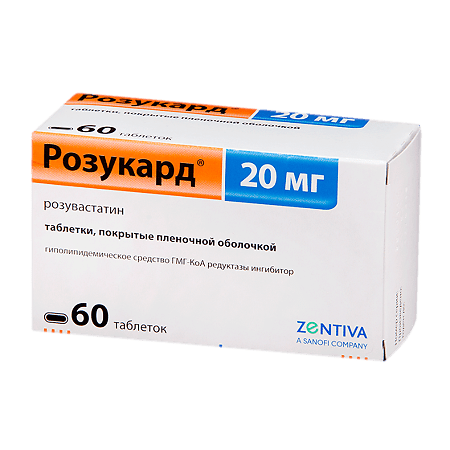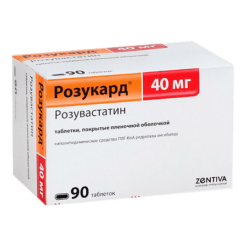No products in the cart.
Rosucard, 20 mg 60 pcs
€1.00
Out of stock
(E-mail when Stock is available)
Description
Hypolipidemic drug from the group of statins. Selective competitive inhibitor of Z-hydroxy-Z-methylglutaryl coenzyme A (HMG-CoA)-reductase – the enzyme that converts HMG-CoA into mevalonate, cholesterol (CH) precursor.
Increases the number of low-density lipoprotein (LDL) receptors on the surface of hepatocytes, which leads to increased capture and catabolism of LDL, inhibiting the synthesis of very low-density lipoproteins (VLDL), reducing the total concentration of LDL and VLDL. Reduces concentrations of CH-LDL, high-density cholesterol-non-lipoproteins (HDL-C), LDL-C, total CH, triglycerides (TG), TG-LDL-C, apolipoprotein B (ApoB), decreases the ratios of CH-LDL/HC-LDL, total CH/CH-LDL, non-HC-LDL/HC-LDL, apoB/apolipoprotein A-1 (apoA-I), increases concentrations of CH-LDL and apoA-I.
Indications
Indications
Active ingredient
Active ingredient
How to take, the dosage
How to take, the dosage
Interaction
Interaction
Special Instructions
Special Instructions
During treatment, especially during dose adjustment of Rosucard®, the lipid profile should be monitored every 2-4 weeks and the drug dose should be changed if necessary.
Liver function tests are recommended prior to therapy and 3 months after the start of therapy. Rosecard® should be discontinued or the dose should be reduced if the serum hepatic transaminase activity is 3 times greater than BHF.
When using Rosucard® at a dose of 40 mg, it is recommended to monitor renal function parameters.
In patients with hypercholesterolemia due to hypothyroidism or nephrotic syndrome, therapy for underlying disease should be performed before starting Rosucard® treatment.
In patients with existing risk factors for rhabdomyolysis, the ratio of expected benefit to potential risk should be considered and clinical monitoring should be conducted throughout the course of treatment.
Patients should be informed to immediately inform their physician if they experience muscle pain, muscle weakness, or cramping, especially if combined with malaise and fever.
In such patients, CPK activity should be determined. Therapy should be discontinued if CPK activity is significantly increased (more than 5 times that of IGN) or muscle symptoms are severe and cause daily discomfort. If symptoms disappear and CPK activity returns to normal, consideration should be given to re-prescribing Rosecard® or other HMG-CoA reductase inhibitors at lower doses with close patient monitoring.
The determination of CPK activity should not be performed after strenuous physical activity or in the presence of other possible reasons for its increase, which may lead to misinterpretation of the results obtained. If the baseline CPK activity is significantly elevated, repeat measurement after 5-7 days – therapy should not be started if the repeat test confirms the baseline CPK activity (5 times higher than normal).
Routine monitoring of CPK activity in the absence of the symptoms described above is inappropriate.
A higher incidence of myositis and myopathy has been reported in patients taking other HMG-CoA reductase inhibitors in combination with fibrates (including gemfibrozil), cyclosporine, nicotinic acid, azole antifungals, protease inhibitors and macrolide antibiotics. The ratio of expected benefit to potential risk in co-administration of Rosecard® and fibrates or nicotinic acid (in lipid-lowering doses – 1 g/day) should be carefully weighed; concomitant administration of gemfibrozil is not recommended.
In most cases, proteinuria decreases or disappears during therapy and does not indicate the occurrence of acute or exacerbation of existing renal disease. Assessment of renal function should be performed during routine evaluation of patients receiving a dose of 40 mg.
The statin class of drugs has the potential to cause elevated blood glucose concentrations. In some patients with high risk of developing diabetes mellitus such changes may lead to its manifestation, which is an indication for prescription of hypoglycemic therapy. However, the reduction in the risk of vascular disease on the background of statins exceeds the risk of diabetes mellitus, so this factor should not serve as a reason for withdrawal of statin treatment. Patients in the risk group (fasting blood glucose concentration 5.6-6.9 mmol/l, BMI >30 kg/m2, hypertriglyceridemia, arterial hypertension in anamnesis) should be monitored by a physician and biochemical parameters should be regularly controlled.
The co-administration of rosuvastatin and HIV protease inhibitors is not recommended.
In long-term use of rosuvastatin single cases of interstitial lung disease have been reported. If interstitial lung disease is suspected, therapy with Rosucard® should be discontinued.
In studying pharmacokinetic parameters of rosuvastatin an increase in systemic drug concentration was noted in mongoloid race (see “Pharmacokinetics”). This fact should be considered when prescribing Rosucard® to these patients.
Impact on the ability to drive vehicles and operate machinery. Caution should be exercised while driving motor transport and doing activities which require high concentration and quick psychomotor reactions (dizziness may occur during the therapy).
Contraindications
Contraindications
Side effects
Side effects
Overdose
Overdose
Similarities
Similarities
Additional information
| Shelf life | 2 years. |
|---|---|
| Conditions of storage | At a temperature not exceeding 25 oC in the original container. |
| Manufacturer | Zentiva k.s., Czech Republic |
| Medication form | pills |
| Brand | Zentiva k.s. |
Other forms…
Related products
Buy Rosucard, 20 mg 60 pcs with delivery to USA, UK, Europe and over 120 other countries.

















